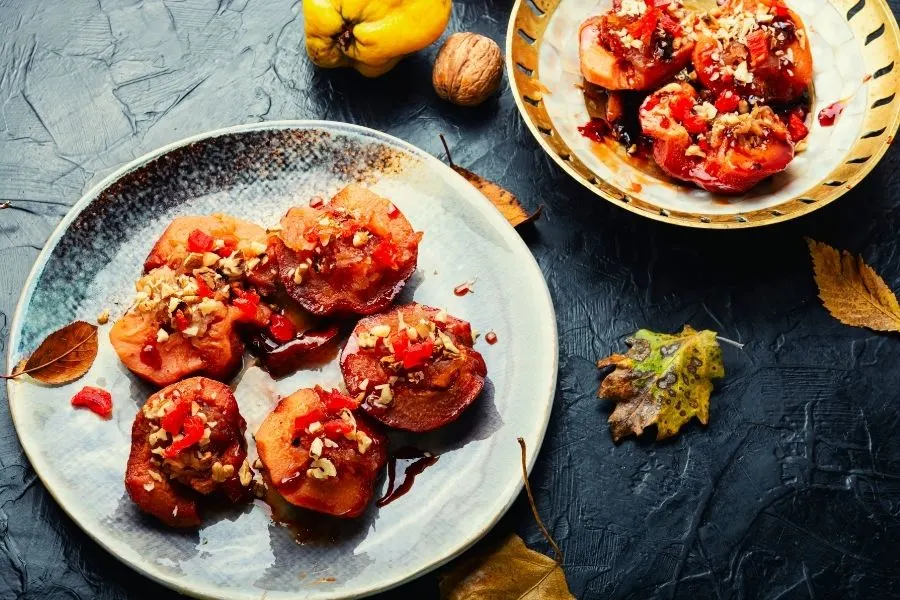Quinces are not a common sight, and they’re not the easiest fruit to find on the market. They’re harvested in late fall, before the first frosts, and they’re not commercially farmed in most countries. You have a higher chance of getting a couple of quinces from a loveable grandma’s backyard than finding them in the supermarket.
But let’s say you do get your hands on some, you’ll naturally want to taste them. And you do, only to find out these bad boys are hard, tough, astringent, and not all that pleasant. So what’s left ? Make some quince paste, or quince cheese as some call it. As you get to work, you notice the quince turning slightly orange, then coral-pink, then a light red.
So why is your quince paste turning red ? Is it normal ? Is it going bad ? It turns out this happens every time, to a degree. So let’s take a look at why it does in the first place.

Why is quince paste red ?
Quince paste turns red when the tannins in quince flesh are broken down, releasing a pigment called anthocyanin. This pigment gives the quinces are reddish hue, because this is a mildly acidic fruit and anthocyanins respond to acids and alkaline substances.
This process happens only as the quinces cook or are subjected to heat. Heat breaks down the cell walls in the fruit, releasing the pectin and the tannins. Heat then opens up the tannins, leading to anthocyanins bleeding into the cooking water and fruit flesh.
These pigments are the same responsible for the color of red onions, red cabbage, cherries, blueberries, beets, and purple carrots.
Do all quinces turn pink when cooked ?
Most quinces turn at least a bit orange-pink when cooked, yes. Some may have a bit more pigment than others, and some may have less. Generally, quinces should at least change their color, even if they don’t turn fully pink.
The reason cooked quinces are not completely pink is because the flesh turns a bit brown, just like an oxidized apple. So the color will never be a true pink, rather a dull coral color.

How do you make quince paste darker ?
You can make quince paste darker by letting it simmer for longer. The more water evaporates, the more intense the color. It could be that the quinces you used were not particularly high in anthocyanins. In that case, there’s only so much you can do, aside from adding extra color via food coloring or other ingredients.
Read also: Why Are Watermelons Red ?
How to pick out a good quince
A good quince is yellow-green, and may have a bit of fuzz on its skin. It should easily be removed if you run your thumb over it. Quinces are dense fruit, so it should not feel light for their size.
Try to find quinces without any bruises or blemishes, this way you’re sure the outer skin is still doing its job and protecting the inner fruit.
How to ripen quinces at home
Quince needs to ripen at home in order to reach its full flavor. Somehow, these fruits do not ripen if left on the tree. So how do you ripen them ?
Unlike most other fruits, quinces don’t need room temperature to ripen. We mean they can sit at room temperature, but it doesn’t speed up the process as much as it does for other fruits.
Quinces are very dense and simply take anywhere from 2 to 6 weeks to soften and ripen on their own. Storing them in the fridge when they’re not ripe will make that timeline even longer.
You need a cool, dark, dry place to store quinces, like maybe a pantry or something similar. Do not keep these in the cellar, because any hint of moisture will turn them moldy. Instead put them away and check on them every week or so.
How do you know the quinces are ripe ? They will be fully yellow and fairly fragrant. This can happen faster for some quinces than others, so be sure to check on them at least once a week.
Read Also: Can You Eat Undercooked Dumplings?
You can’t really eat raw quince
Even when the quinces are ripe, they’re still kind of hard to eat. They’re astringent, and they’re very, very tough. This isn’t the kind of fruit you can eat as-is, like an apple or pear, although it’s very closely related to these.
Instead quinces need to be cooked, in any way you can imagine. It could be jam (or paste), it could be compote, it could be a simple sauce to go along with some red meat, anything you like. Just keep in mind it needs some serious cooking time to soften.
So now you know why quinces turn red, or even an orange-pink sort of shade. As long as you cook them in any way, quinces are perfectly edible and delicious.

